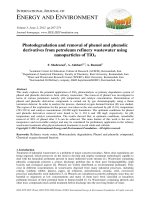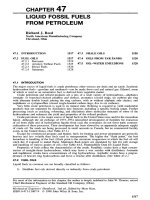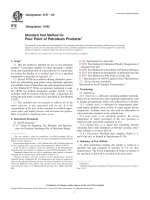Petroleum geology
Bạn đang xem bản rút gọn của tài liệu. Xem và tải ngay bản đầy đủ của tài liệu tại đây (5.47 MB, 49 trang )
The Magic of Petroleum
ENVIR 100
Nov 5, 2008
The Prize
• In 1970, several major
US oil companies paid
the government millions
of dollars for oil-drilling
rights off the coast of
Oregon and Washington
• They drilled three holes,
then abandoned the
operation, losing millions
of dollars
What went wrong?
• They forgot the story about the Texas county
that produced oil after 30 dry holes were drilled
• They did not listen to the economists telling them
that the amount of oil discovered depends on the
number of dollars spent on the search
• Environmentalists were better organized in
Oregon and Washington than anywhere else
• There was really bad news in those three holes
• All/None of the above
A key concept in the reading was…
1. Hubbert’s folly
2. Hubbert’s peak
3. Hubbert’s
equilibrium
4. Hubbert’s squash
81%
9%
9%
1%
1
2
3
4
The time scale relevant for oil
formation is know as
1.
2.
3.
4.
“Geologic time”
“Paleologic time”
“Neologic time”
“Hammer time”
72%
18%
9%
1%
“Geologic time”
“Neologic time”
“Hammer time”
“Paleologic time”
The author of the article argues that
world oil production will decline
1.
2.
3.
4.
By 2100
By 2050
By 2010
Never
56%
34%
7%
By 2100
3%
By 2050
By 2010
Never
The Magic of Petroleum
Outline
I. Where does petroleum
come from?
II. Petroleum - A Strategic
Natural Resource
I. Where does petroleum come
from?
What is petroleum?
• Petroleum: A general term for all
naturally occurring hydrocarbons
(hydrogen + carbon)
• Solid Hydrocarbons: Asphalt
• Liquid Hydrocarbons: Crude oil
• Gas Hydrocarbons: Natural Gas:
methane, butane, propane, etc.
The simplest
hydrocarbon is Methane
(CH4)
1. Source Rocks
Organic Matter
• Sedimentary rocks rich in
organic matter
– 0.5 - 2% by weight
• Most commonly
microscopic marine
material, but it can be
land based material
• Organic material cannot
decay too much
– It has to keep its carbon
1. Source Rocks
Modern Sedimentary Basins
• Gulf of Mexico
• Parts of the
Mediterranean and
Black Sea
2. Transform organic matter
Add heat and pressure by burying it (Maturation)
3. Carrier beds
Oil on the move
• Oil is less dense than water and
will rise through the fluid system
of the surrounding rock
• Carrier beds are rock layers
that allow fluids to pass through
them
– Ex: Sandstone
• If petroleum stays buried, it can
become post-mature
4. Traps
• If nothing stops oil
from rising, it will reach
surface
– Ex: The La Brea tar pits
• Traps can be rocks
that do not allow fluids
to pass through them,
or folds and faults in
the rock can trap
petroleum
5. Reservoir rocks
The oil needs to be trapped in a good place
• A good reservoir
rock is:
– Porous: holes
– Permeable: holes
are connected
– so that its fluids
can be produced
(removed from
them)
6. Proper timing
• Timing between
accumulation of
organic material,
petroleum maturation,
migration, and trap
formation is vital
Review: Where does petroleum come from?
1. Source rocks rich in organic matter
2. Transform the organic material with heat and
pressure to into petroleum (Maturation)
3. Carrier beds that allow the generated
petroleum to move
4. Traps that keep the petroleum below ground
5. Adequate reservoir beds from which the
petroleum can be extracted
6. Proper timing of events 1-5
Why is there oil in Texas?
II. A Strategic Natural Resource
National Geographic, 2002
Strategic Natural Resource
A) a resource that
supports military
power in a vital way
B) a resource to which
states would be
willing to fight to
protect their access to
US Energy Information Administration
World Wars
• World War One
– Churchill switches
British navy to diesel
• World War Two
– Japanese oil embargo
• Carter Doctrine, 1980
What do we get from oil?
• 1 barrel = 42 gallons
of crude oil
• 83% becomes fuel
– Gasoline, diesel, jet
fuel, heating oil, and
liquefied petroleum gas
(propane and butane)
• 17% other
– Solvents, fertilizers,
pesticides, plastics
* These add up to 44.6 gallons
because volume is increased
during the refining process.
US Energy Information Administration
How much oil do we use?
• US consumes
20,680,000 barrels of
oil each day (2007)
• US motor gasoline
consumption
9,286,000 b/d (390
million gallons/day)
(2007)
• World consumes
83,607,000 b/d (2005)
US oil consumption 1980-2006
US Energy Information Administration
Where do we get our oil from?
US Energy Information Administration
2007 US Imports by Country
Rank
Country
Mb/d
1
Canada
2.5
2
Mexico
1.5
3
Saudi Arabia
1.5
4
Venezuela
1.4
5
Nigeria
1.1
6
Algeria
0.67
7
Iraq
0.48
8
Angola
0.51
9
Russia
0.41
All Countries
13.5
Non-OPEC
8.1
OPEC
5.98
Total
US Energy Information Administration









